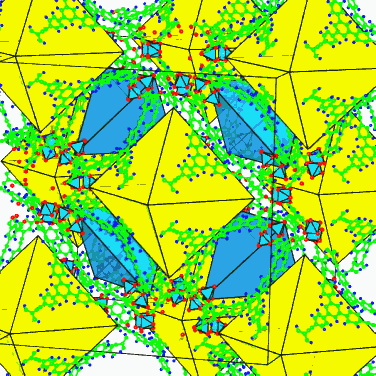Crystallographic analysis of x-ray and neutron diffraction data is a widely used technique to provide three-dimensional (3-D) pictures of how atoms are arranged in materials, an essential first step toward understanding a material’s function. Computer software is an indispensable part of the crystallographic analysis process. A recent citation milestone demonstrates the great contribution to science that is made by a pair of such programs authored by two Argonne scientists.
The General Structural Analysis System (GSAS) package is unique in that it can be used to fit crystallographic models to all types of diffraction data: powder diffraction and single-crystal diffraction; synchrotron, neutron, or lab x-ray; constant wavelength or energy dispersive. It can be used to fit models ranging from simple inorganics to proteins; it can even model magnetic scattering. For complex problems where one technique alone is not enough, data from multiple types of measurements can be combined. GSAS was co-authored by Argonne scientist Robert B. Von Dreele of the X-ray Science Division (XSD), who continues to support the project.
Another package, called EXPGUI, provides an easy-to-learn user interface to GSAS and extends its capabilities. It also simplifies installation and use. In April 2001, its author, Argonne scientist Brian H. Toby (XSD) described his work in a paper, "EXPGUI, a Graphical User Interface for GSAS" in the Journal of Applied Crystallography. Nine years later to the month, this paper received its thousandth citation, as tracked by the Thomson Reuters ISI Web of Science citation database. The number of citations received by a paper is an important measure of a work's influence. Using citation analysis baselines included in the Thomson Reuters database Essential Science Indicators, Argonne research librarian Mary Straka explained that for chemistry papers published in 2001, the percentage of papers that have been cited 1000 times is somewhere between 1 in 1,000 and 1 in 10,000. Citations to GSAS are not tracked in the ISI database, but approximately 5,000 citations have been located by other means. The citations to EXPGUI demonstrate not only how many scientific projects the software facilitated, but also how wide a range of research areas benefitted. The ISI categorizes the citations in 62 different subject areas in fields covering chemistry, physics, materials science, biology, engineering and geosciences.
Since 2005, the number of papers citing using EXPGUI continues to grow by 12 to 25% each year: In fact, EXPGUI was cited more times in 2009 alone than from 2001 through most of 2005. Toby attributes the success of GSAS and EXPGUI to their sustained development and support, as well as their continual adaptation to run on all commonly-used computing platforms. GSAS defined the state of the art when first developed in the 1980's and has continued to pioneer new approaches in crystallographic data analysis. For EXPGUI, even as the package was reaching this milestone, its distribution method was revamped so that users will be able to receive the latest updates to both packages at the click of a button.
Von Dreele and Toby are already planning for the next generation of crystallographic analysis. Thanks to Strategic Laboratory Directed Research and Development support from Argonne, they have started work on a new project called GSAS-II, which will eventually include the capabilities of GSAS and EXPGUI, as well as perform analyses not currently possible.
The Advanced Photon Source (APS) at Argonne National Laboratory is one of five national synchrotron radiation light sources supported by the U.S. Department of Energy’s Office of Science, Office of Basic Energy Sciences (DOE-BES). The APS is the source of the Western Hemisphere’s brightest high-energy x-ray beams for research in virtually every scientific discipline. More than 3,500 scientists representing universities, industry, and academic institutions from every U.S. state and several foreign nations visit the APS each year to carry out applied and basic research in support of the BES mission to understand, predict, and ultimately control matter and energy at the electronic, atomic, and molecular levels in order to provide the foundations for new energy technologies and to support DOE missions in energy, environment, and national security. To learn more about the Office of Basic Energy Sciences and its x-ray user facilities. This work was supported by the DOE-BES, under Contract No. DE-AC02-06CH11357.
The nation's first national laboratory, Argonne conducts leading-edge basic and applied scientific research in virtually every scientific discipline. Argonne researchers work closely with researchers from hundreds of companies, universities, and federal, state and municipal agencies to help them solve their specific problems, advance America's scientific leadership and prepare the nation for a better future. With employees from more than 60 nations, Argonne is managed by UChicago Argonne, LLC for the U.S. Department of Energy's Office of Science.

